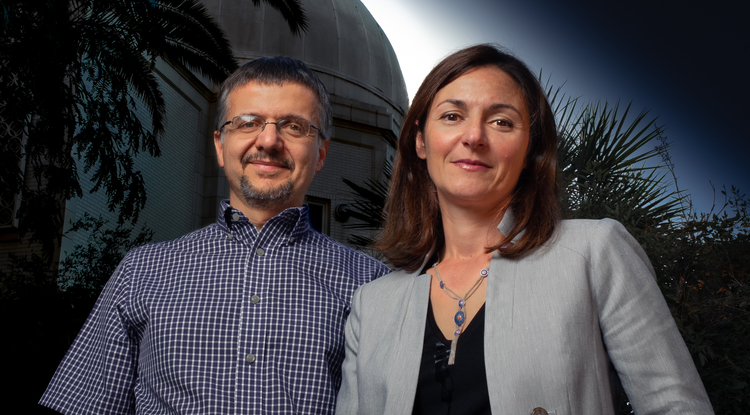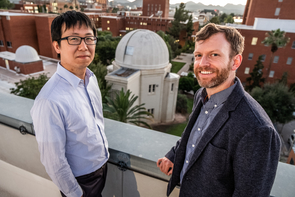$3M Breakthrough Prize Goes to Black Hole Hunters Including UA Astrophysicists

Dimitrios Pslatis, EHT project scientist, and Feryal Ozel, lead of the modeling analysis working group, are two of several University of Arizona researchers who contributed to the Event Horizon Telescope project, which was awarded the Breakthrough Prize in Fundamental Physics. (Photo: Bob Demers/UANews)
The Event Horizon Telescope collaboration, which included several University of Arizona researchers and students, received a prestigious award for producing the first image of a supermassive black hole, taken by means of an Earth-sized alliance of telescopes.
By Daniel Stolte | University Communications | Sept. 5, 2019

The 347 authors of the first six published papers from the EHT project, including University of Arizona faculty members Chi-kwan Chan, leader of the computations and software working group, and Dan Marrone, one of the four leads who announced the first image of a black hole, will all receive equal portions of the $3 million prize money. (Photo: Bob Demers/UANews)
Researchers from the University of Arizona are named in a collaboration that will receive the 2020 Breakthrough Prize, also known as the “Oscars of Science.” Considered the world’s most generous science prize, each Breakthrough Prize comes with $3 million in prize money.
Dimitrios Psaltis, Feryal Ozel, Chi-kwan Chan and Dan Marrone are part of the Event Horizon Telescope project, which was just awarded the 2020 Breakthrough Prize in Fundamental Physics for capturing the first-ever photo of a black hole in space.
The result of years of international collaboration, the EHT offers scientists a new way to study the most extreme objects in the universe. Until the EHT’s historic photo, the existence of black holes had only been inferred from Einstein’s Theory of General Relativity and other measurements, but never directly observed.
The prize money will be split equally among all the members of the Event Horizon Telescope, or EHT, collaboration who co-authored the initial discovery, which was published on April 10 in six scientific papers.
The University of Arizona has 36 researchers, students and telescope support staff contributing to the EHT project that created the first image of the black hole, including:
- Dimitrios Pslatis, the EHT project scientist;
- Feryal Ozel, lead of the modeling analysis working group;
- Chi-kwan Chan, leader of the computations and software working group;
- Dan Marrone, one of the four leads who announced the first image; and,
- 21 UA students, who were involved in the project at the time the image was released.
The UA also managed two of the eight telescopes involved in gathering the data that resulted in the image of the supermassive black hole in the center of M87, a galaxy in the Virgo galaxy cluster 55 million light-years from Earth.
“A huge congratulations to all the Event Horizon Telescope contributors for this outstanding award,” said UA President Robert C. Robbins. “The University of Arizona community is incredibly proud of the longstanding tradition of leadership in astronomy and space exploration, and it is fitting that Dimitrios Psaltis, Feryal Ozel, Chi-kwan Chan, Dan Marrone, and many UA students were involved with this collaborative international project. The first ever picture of a black hole is a fantastic triumph of human endeavor, and I am thrilled to see it recognized with the Breakthrough Prize in Fundamental Physics.”

On April 10, EHT researchers revealed the first direct visual evidence of the supermassive black hole in the center of Messier 87 and its shadow. (Image: EHT Collaboration)
The Breakthrough Prize Foundation and its founding sponsors – Sergey Brin, Priscilla Chan and Mark Zuckerberg, Ma Huateng, Yuri and Julia Milner, and Anne Wojcicki – together are awarding a collective $21.6 million through the 2020 Breakthrough Prize and 2020 New Horizons Prize in recognition of important achievements in the life sciences, fundamental physics, and mathematics.
This year’s winners are credited with discoveries that address important and compelling scientific questions, from “Why do chilis taste hot?” and “What are the causes of neurodegenerative disease?” to “What does a black hole look like?”
Taking a direct image of the black hole in M87 is a feat that would not have been possible a decade ago. Even though the object is about the size of our solar system, it is so far away that resolving its features across 55 million light-years is like “taking a picture of a doughnut placed on the surface of the moon,” according to EHT Project Scientist Dimitrios Psaltis, a professor of astronomy and physics at the University of Arizona.
Now in its eighth year, the Breakthrough Prize annually recognizes achievements in the life sciences, fundamental physics and mathematics, disciplines that ask the biggest questions and seek the deepest explanations.
The new laureates will be recognized at the eighth annual Breakthrough Prize gala awards ceremony on November 3 at the NASA Ames Research Center in Mountain View, California, and broadcast live on National Geographic. Each year, the program has a theme, and this year’s topic – “Seeing the Invisible” – is inspired by the Event Horizon Telescope collaboration, which created the first image of a black hole, as well as the broader power of science and mathematics to reveal hidden, uncharted worlds.
Although the Breakthrough citation included only the 347 people listed as authors on the first six papers, there are even more people who contributed to the success of the endeavor. The full contingent of University of Arizona EHT participants is as follows: researchers Chi-Kwan Chan, Pierre Christian, Tod Lauer (NOAO research staff), Dan Marrone, Feryal Ozel, Dimitrios Psaltis, Buell Jannuzi and Lucy Ziurys; graduate students David Ball, Junhan Kim (graduated 2019), Lia Medeiros (graduated 2019), Carolyn Raithel, Mel Rose, Arash Roshanineshat, Kaushik Satapathy and Tyler Trent; current and former undergraduates Joseph Allen, Devin Cameron, Elizabeth Champagne, Landen Conway, Ryan Gatski, Dalton Glove, Yuan Jea Hew, Kyle Massingill, Kaylah McGowan, Jose Perez, Will Price, Gustavo Rodriguez, Anthony Schlecht and Alexis Tinoco; and Steward Observatory staff Patrick Fimbres, Thomas Folkers, David Forbes, Robert Freund, Christopher Greer, Christian Holmstedt, Gene Lauria, Martin McColl, Robert Moulton and George Reiland.
Link to original article here.